Authenticity Regulations
Headgear
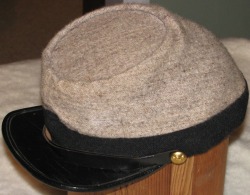
1. Kepi or Forage Cap - Gray jean wool or black, tarred canvas or leather bill, leather or painted cloth sweatband (EOG/CS - pages 163 & 163)
2. Civilian Slouch Hat - Black, Brown, or Gray. Edge of brim as well as hat band should be bound with silk ribbon, hand or machine sewn on. Leather or Cotton Duck sweatband should be handsewn in. Cloth lining is highly recommended but not required. (EOG/CS - pages 166 - 169)
3. CS issue hat - Wool Felt, hand-stitched leather sweatband, label in crown, double stitched on brim (North South Trader Magazine, Vol. XVIII Number 6,
Shirts
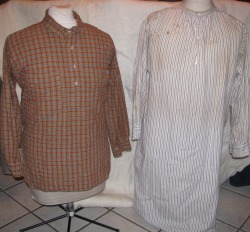
1. Civilian Shirts - Fabrics must be woven of 100% natural fibers, i.e. cotton or wool. Plaids and checks should be woven. Basic assembly may be machine sewn, but exterior details and buttonholes shall be handsewn. Buttons shall be of appropriate size and made of glass, bone, agate or wood. (EOG/US - page 126, EOG/CS - pages 154 & 155)
2. Military Issue Shirts - Fabrics must be woven of 100% natural fibers, i.e. cotton or wool. Military issue shirts were made of primarily of heavy unbleached muslin, osnaburg, or wool flannel. Basic assembly may be machine sewn, but exterior details and buttonholes shall be handsewn. Buttons shall be of appropriate size and made of glass, bone, agate or wood. In either case, no prints or machine stitched button holes. (EOG/US - page 126, EOG/CS - pages 154 & 155)
2. Military Issue Shirts - Fabrics must be woven of 100% natural fibers, i.e. cotton or wool. Military issue shirts were made of primarily of heavy unbleached muslin, osnaburg, or wool flannel. Basic assembly may be machine sewn, but exterior details and buttonholes shall be handsewn. Buttons shall be of appropriate size and made of glass, bone, agate or wood. In either case, no prints or machine stitched button holes. (EOG/US - page 126, EOG/CS - pages 154 & 155)
Jackets/Coats/Battle shirts
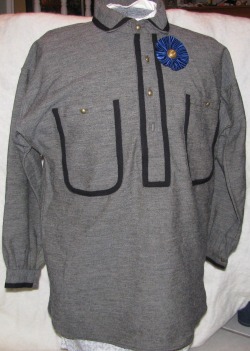
1. Overshirt or Battle Shirt: Jean or Wool Flannel trimmed with tape. Wood, bone or brass buttons.
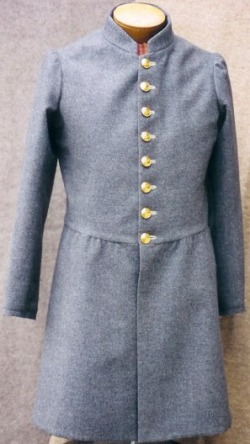
2. Commutation Garments, frock coat, short jackets, fatigue blouse made from jeans cloth, satinet, cassimere.
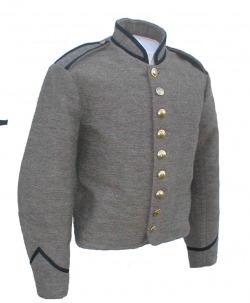
3. Richmond Depot Type I jacket, made of Jeans, Cassimere, Satinette or Cassimere. Jackets will be fully lined with cotton osnaburg with one internal left breast pocket. The 9-button front is standard although 8-button fronts are acceptable in limited numbers. Buttons should generally be CS or US issue, though state, coin, or wooden buttons may be used where documented. NCO insignia should not be worn despite the rank within a unit. When rank insignia is worn, only cotton or woolen tape trim shall be used, which should be hand sewn directly onto the sleeves. Embroidered patch rank type insignia are not permitted. The Jacket to be trimmed with black ¼ inch worsted wool tape, around color, shoulder strap & a V pattern on cuff.

4. Officer's Uniforms. Uniforms worn by officers will follow identified patterns and materials. Frock coats of kersey, satinette or broadcloth are preferred during the '61 though '63 time period. Frock coats worn by officers should generally be trimmed. Both single and double-breasted frock coats are documented as correct, but double-breasted frock coats are under-represented in the field and are therefore preferred. Likewise, while enlisted men’s jackets with officer insignia are documented, preference should be given to tailor-made jackets of a pattern attributed to officer use. Identified examples should be used as a guide.
Trousers
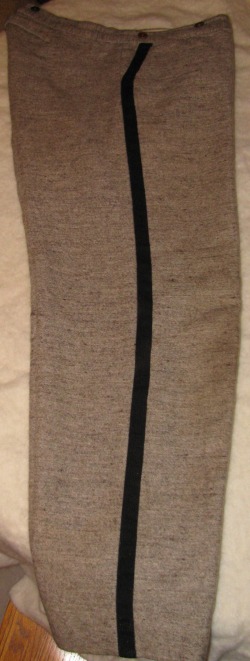
1. Civilian Jean - Original Patterns in gray, blue, brown or black. Handtop stitching, with hand sewed button holes (EOG/CS - pages 125, 1245, 146, 152 & 153). Buttons of bone, composition or stamped tin.
2. Civilian Wool - Identified style and pattern, hand-sewn button holes (EOG/CS - page 152. Buttons of bone or composition.
3. Military Issue - Richmond Depot style - Mule ear pockets, no yoke. Back belt with buckle. Made from jeans or cassimere for time period of Spring '62 through Winter '64. English Army Cloth trousers in gray/blue kersey of the proper weight may be used for Spring '64 through Appomattox. Buttons may be bone, composition, or japanned tin of the proper style. Confederate issue wooden trouser buttons are acceptable in limited numbers after Spring '64. Hand finished top stitching and button holes.
4. Military Issue - Other Depot Styles. Side seam pockets, no yoke. Back belt with buckle, and made from jeans or cassimere. Buttons may be bone, composition, or japanned tin of the proper style. Confederate issue wooden trouser buttons are acceptable in limited numbers after Spring '64. Hand finished top stitching and button holes
2. Civilian Wool - Identified style and pattern, hand-sewn button holes (EOG/CS - page 152. Buttons of bone or composition.
3. Military Issue - Richmond Depot style - Mule ear pockets, no yoke. Back belt with buckle. Made from jeans or cassimere for time period of Spring '62 through Winter '64. English Army Cloth trousers in gray/blue kersey of the proper weight may be used for Spring '64 through Appomattox. Buttons may be bone, composition, or japanned tin of the proper style. Confederate issue wooden trouser buttons are acceptable in limited numbers after Spring '64. Hand finished top stitching and button holes.
4. Military Issue - Other Depot Styles. Side seam pockets, no yoke. Back belt with buckle, and made from jeans or cassimere. Buttons may be bone, composition, or japanned tin of the proper style. Confederate issue wooden trouser buttons are acceptable in limited numbers after Spring '64. Hand finished top stitching and button holes
. Suspenders / Braces / Belts
1. Civilian - Any type of period civilian model with tin or brass buckles. No buckles of nickel - or other plated metal. Any stitching should be handsewn.
2. Canvas or Ticking - hand stitched with hand sewn button holes.
3. Belts – Leather with roller buckle.
Drawers
1. Civlian Pattern - Cotton Osnaburg or muslin, cotton or wool flannel. Bone, glass or wood buttons with hand sewn button holes. (EOG/CS - page 154)
2. Military Pattern - Cotton Osnaburg or muslin or cotton flannel. Bone, glass or wood buttons with hand sewn button holes. (EOG/US - page 27)
Socks
1. Civilian Socks, particularly hand knitted cotton or wool (EOG/CS - page 175). Modern rag wool socks are not acceptable.
2. Military Issue Socks, machine knitted cotton. Proper pattern and finishing.
Shoes
1. Confederate Issue Shoes (EOG/CS - pages 174 & 175)
2. English boots or shoes - Military or Civilian Styles (EOG/CS - page 174). Should generally be used only at late-War events.
3. Identified Civilian boots or shoes - Boots and shoes of a civilian pattern which have been identified are permitted. For impressions after Winter 1862, boots had generally limited use in most infantry units. (EOG/US - page 172)
4. Federal Issue Shoe - Generally limited Confederate use. (EOG/US - page 191)
Waistcoats / Vests
1. Civilian Made - Period civilian or military styles. Made from correct wool, jean, cassimere or satinette. Wool kersey and linsey-woolsey, or cotton. Fully lined, hand topstitched, with handsewn button holes. (EOG/CS - pages 101, 106, 113 & 114)
1. Civilian - Any type of period civilian model with tin or brass buckles. No buckles of nickel - or other plated metal. Any stitching should be handsewn.
2. Canvas or Ticking - hand stitched with hand sewn button holes.
3. Belts – Leather with roller buckle.
Drawers
1. Civlian Pattern - Cotton Osnaburg or muslin, cotton or wool flannel. Bone, glass or wood buttons with hand sewn button holes. (EOG/CS - page 154)
2. Military Pattern - Cotton Osnaburg or muslin or cotton flannel. Bone, glass or wood buttons with hand sewn button holes. (EOG/US - page 27)
Socks
1. Civilian Socks, particularly hand knitted cotton or wool (EOG/CS - page 175). Modern rag wool socks are not acceptable.
2. Military Issue Socks, machine knitted cotton. Proper pattern and finishing.
Shoes
1. Confederate Issue Shoes (EOG/CS - pages 174 & 175)
2. English boots or shoes - Military or Civilian Styles (EOG/CS - page 174). Should generally be used only at late-War events.
3. Identified Civilian boots or shoes - Boots and shoes of a civilian pattern which have been identified are permitted. For impressions after Winter 1862, boots had generally limited use in most infantry units. (EOG/US - page 172)
4. Federal Issue Shoe - Generally limited Confederate use. (EOG/US - page 191)
Waistcoats / Vests
1. Civilian Made - Period civilian or military styles. Made from correct wool, jean, cassimere or satinette. Wool kersey and linsey-woolsey, or cotton. Fully lined, hand topstitched, with handsewn button holes. (EOG/CS - pages 101, 106, 113 & 114)
II. Blankets/Tents
.
A. Blankets
1. Civilian - 100% Wool or Jean - No synthetic blends. Should be muted earth tones. Browns, grays, and blue are acceptable colors. Bindings should be hand sewn.
2. North Carolina Issue (EOG/CS - page 203) or Other Confederate State Issues
3. Quilts - "Homespun" i.e. all hand made - All natural fibers. No "bright" or otherwise modern colors. No modern patterns. Size variable from 40"x72" to 50"x80".
4. Captured U.S. Issue - U.S. Issue blankets of either gray or brown. (EOG/US - page 214)
B. Tentage -
1. Captured shelter half, early war style (shorter version), 100% canvas with NO brass grommets or rope. Hand sewn button holes with bone buttons. Limited use (EOG/US - page 214)
2. Confederate "issue" rain fly - Cotton canvas grommets of appropriate size and material. Dimensions should generally be no more than 8 ft x 12 ft.
3. Common tents – The so-called “A-tent” is suitable only for garrison impressions. It should be constructed of 100% canvas with no brass grommets. Tent poles may be square or hexagonal wood.
C. Gum Blankets / Ground Cloths:
1. Linseed soaked cotton canvas - with or without sewn grommets.
2. Linseed oil & Lamp Black mix painted cotton canvas or drill - with or without sewn grommets.
3. Confederate Issue Oil Cloth - Canvas painted with oil or enamel paint. With or without sewn grommets.
4. Captured Federal Issue - Rubber blanket or poncho. Limited use (EOG/US - page 215)
5. Rubber coated linen or cotton sheeting. Imported, limited use.
A. Blankets
1. Civilian - 100% Wool or Jean - No synthetic blends. Should be muted earth tones. Browns, grays, and blue are acceptable colors. Bindings should be hand sewn.
2. North Carolina Issue (EOG/CS - page 203) or Other Confederate State Issues
3. Quilts - "Homespun" i.e. all hand made - All natural fibers. No "bright" or otherwise modern colors. No modern patterns. Size variable from 40"x72" to 50"x80".
4. Captured U.S. Issue - U.S. Issue blankets of either gray or brown. (EOG/US - page 214)
B. Tentage -
1. Captured shelter half, early war style (shorter version), 100% canvas with NO brass grommets or rope. Hand sewn button holes with bone buttons. Limited use (EOG/US - page 214)
2. Confederate "issue" rain fly - Cotton canvas grommets of appropriate size and material. Dimensions should generally be no more than 8 ft x 12 ft.
3. Common tents – The so-called “A-tent” is suitable only for garrison impressions. It should be constructed of 100% canvas with no brass grommets. Tent poles may be square or hexagonal wood.
C. Gum Blankets / Ground Cloths:
1. Linseed soaked cotton canvas - with or without sewn grommets.
2. Linseed oil & Lamp Black mix painted cotton canvas or drill - with or without sewn grommets.
3. Confederate Issue Oil Cloth - Canvas painted with oil or enamel paint. With or without sewn grommets.
4. Captured Federal Issue - Rubber blanket or poncho. Limited use (EOG/US - page 215)
5. Rubber coated linen or cotton sheeting. Imported, limited use.
III. Accoutrements:
A. Haversacks
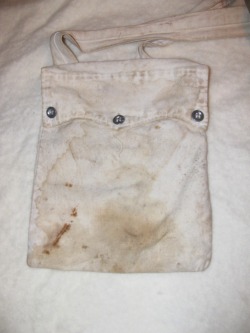
1. C.S. Issue - Bag of identified C.S. pattern. Button or buckle enclosure. (EOG/CS - Page ##)
2. U.S. Issue - Bag of identified U.S. pattern. Tarred type with buckle and inner bag with hand sewn button hole(s). (EOG/US - pages 199, 210, and 211)
2. U.S. Issue - Bag of identified U.S. pattern. Tarred type with buckle and inner bag with hand sewn button hole(s). (EOG/US - pages 199, 210, and 211)
B. Canteens
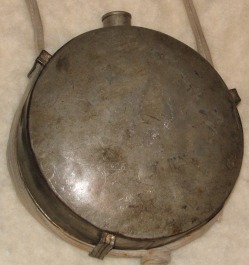
1. Wooden Style - Made of cedar/cypress/cherry/etc. Various styles. Confederate and British manufacture. (EOG/CS - page 209)
2. Tin Drum Style - Various styles and sizes. Avoid oversize or very large canteens of this type. With or without jean or wool cover. Strap may be cotton, linen or leather or a properly documented style. Leather straps must have proper hardware. (EOG/CS - pages 210 & 211)
3. U.S. Issue - Smooth side type - With or without jean cloth or wool cover. Strap may be cotton, linen or leather or a properly documented style. Leather straps must have proper hardware. (EOG/US - pages 199, 209, 207 & 208)
2. Tin Drum Style - Various styles and sizes. Avoid oversize or very large canteens of this type. With or without jean or wool cover. Strap may be cotton, linen or leather or a properly documented style. Leather straps must have proper hardware. (EOG/CS - pages 210 & 211)
3. U.S. Issue - Smooth side type - With or without jean cloth or wool cover. Strap may be cotton, linen or leather or a properly documented style. Leather straps must have proper hardware. (EOG/US - pages 199, 209, 207 & 208)
C. Cartridge Boxes -
Shoulder worn cartridge box slings shall generally be black leather, but painted canvas with leather end tabs are acceptable. Buff leather should be limited to early war and militia impressions.
1. Any Army of Northern Virginia identified box.
2. Richmond Arsenal (EOG/CS - page 197)
3. English Made Imported Enfield Pattern Cartridge Box
4. Christian S. Storms (CS Storms of New York, NY - Contractor box)
"Directory of American Military Goods Dealers and Makers, 1785-1915" by Bazelon and McGuinn - page 160.
5. Captured Federal issue 1855 .58 cal Cartridge Box - Early versions, general use. Later war issue, limited use. Model 1842 .69 cal. boxes and follow on variants for either belt or sling carriage.
D. Cap Pouches
1. Any Army of Northern Virginia identified pouch. Generally black leather. Russet leather - limited use.
2. Tarred canvas, limited Confederate use (EOG/CS - page 198)
3. Federal Issue - Black Leather - Shield front or other common type.
4. Imported S. Isaac's & Campbell
E. Belt Plates / Frames / Waist belts
- Belts to be made with leather, preferably black as russet was generally issued on a limited basis within the ANV. Painted canvas for later war use is acceptable. Buff leather should be used for very early war or militia impressions except imported British types. Most CS issue belts used a simple frame or roller buckle rather than a state or CS/CSA plate.
1. Any Army of Northern Virginia identified plate or buckle.
2. Georgia Frame Plate (EOG/CS - page 190 & 195)
3. C.S. "Forked - Tongue" Buckle (EOG/CS - page 196)
4. Roller Buckle (EOG/CS - pages 192 & 195)
5. Richmond Arsenal - painted canvas - Roller Buckle or used with plate. Issued after Summer '63.
F. Bayonet Scabbards - Bayonets shall have an appropriate scabbard in order for it to be carried. Scabbards shall have a proper metal tip.
1. Any identified ANV frog and scabbard.
2. Imported English frog and scabbard. (EOG/CS - page 39)
3. U.S. non-regulation 7 or 8 rivet pattern. Limited use. (EOG/US - page 202)
G. Knapsacks - (Optional)
1. Mexican War Pattern (EOG/CS - page 39)
2. Imported English - S. Isaac & Campbell Co. or Ross & Co. (EOG/CS - page 207)
3. Confederate Issue - Manufacture of any above style.
4. Federal Issue Double Bag - Limited Confederate use (EOG/US - pages 212 & 213)
Shoulder worn cartridge box slings shall generally be black leather, but painted canvas with leather end tabs are acceptable. Buff leather should be limited to early war and militia impressions.
1. Any Army of Northern Virginia identified box.
2. Richmond Arsenal (EOG/CS - page 197)
3. English Made Imported Enfield Pattern Cartridge Box
4. Christian S. Storms (CS Storms of New York, NY - Contractor box)
"Directory of American Military Goods Dealers and Makers, 1785-1915" by Bazelon and McGuinn - page 160.
5. Captured Federal issue 1855 .58 cal Cartridge Box - Early versions, general use. Later war issue, limited use. Model 1842 .69 cal. boxes and follow on variants for either belt or sling carriage.
D. Cap Pouches
1. Any Army of Northern Virginia identified pouch. Generally black leather. Russet leather - limited use.
2. Tarred canvas, limited Confederate use (EOG/CS - page 198)
3. Federal Issue - Black Leather - Shield front or other common type.
4. Imported S. Isaac's & Campbell
E. Belt Plates / Frames / Waist belts
- Belts to be made with leather, preferably black as russet was generally issued on a limited basis within the ANV. Painted canvas for later war use is acceptable. Buff leather should be used for very early war or militia impressions except imported British types. Most CS issue belts used a simple frame or roller buckle rather than a state or CS/CSA plate.
1. Any Army of Northern Virginia identified plate or buckle.
2. Georgia Frame Plate (EOG/CS - page 190 & 195)
3. C.S. "Forked - Tongue" Buckle (EOG/CS - page 196)
4. Roller Buckle (EOG/CS - pages 192 & 195)
5. Richmond Arsenal - painted canvas - Roller Buckle or used with plate. Issued after Summer '63.
F. Bayonet Scabbards - Bayonets shall have an appropriate scabbard in order for it to be carried. Scabbards shall have a proper metal tip.
1. Any identified ANV frog and scabbard.
2. Imported English frog and scabbard. (EOG/CS - page 39)
3. U.S. non-regulation 7 or 8 rivet pattern. Limited use. (EOG/US - page 202)
G. Knapsacks - (Optional)
1. Mexican War Pattern (EOG/CS - page 39)
2. Imported English - S. Isaac & Campbell Co. or Ross & Co. (EOG/CS - page 207)
3. Confederate Issue - Manufacture of any above style.
4. Federal Issue Double Bag - Limited Confederate use (EOG/US - pages 212 & 213)
IV. Weapons
All original muskets must look new and be in safe and proper working order. Proper modifications of reproduction weapons must include removal of all anachronistic workings [markings??], burnishing of questionable parts, replacement of barrel bands, finishing stocks with boiled linseed oil, and stamping of correct markings. Weapon type should be appropriate for impression.
All soldiers should posses a bayonet appropriate for the musket or rifle they are carrying. Bayonets shall have an appropriate and serviceable scabbard in order for it to be carried.
A.US 1861 Rifled Musket .58 cal. Springfield or Gov't Contractor. Stock finished in boiled linseed oil. Burnished finish.
B. P1853 Enfield Rifled Musket, .577 cal. burnished finish. Stock finished with boiled linseed oil.
C. 69 cal. Smoothbore Muckets.
**ALL LONG ARMS SHALL HAVE BAYONET WITH WEAPON!




